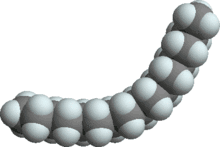Hexadecane
 | |
 | |
| Names | |
|---|---|
| IUPAC name
Hexadecane[1] | |
| Other names
Cetane | |
| Identifiers | |
3D model (JSmol) |
|
| 1736592 | |
| ChEBI | |
| ChEMBL | |
| ChemSpider | |
| ECHA InfoCard | 100.008.072 |
| EC Number | 208-878-9 |
| 103739 | |
| MeSH | n-hexadecane |
PubChem CID |
|
| |
| |
| Properties | |
| C16H34 | |
| Molar mass | 226.45 g·mol−1 |
| Appearance | Colourless liquid |
| Odor | Gasoline-like to odorless |
| Density | 0.77 g/cm3[2] |
| Melting point | 18 °C (64 °F; 291 K)[2] |
| Boiling point | 287 °C (549 °F; 560 K)[2] |
| log P | 8.859 |
| Vapor pressure | < 0.1 mbar (20 °C) |
Henry's law constant (kH) |
43 nmol Pa−1 kg−1 |
| -187.63·10−6 cm3/mol | |
Refractive index (nD) |
1.434 |
| Thermochemistry | |
Heat capacity (C) |
499.72 J K−1 mol−1 or 2.21 J K−1 g−1 |
Std molar entropy (S |
586.18 J K−1 mol−1 |
Std enthalpy of formation (ΔfH |
−458.3–−454.3 kJ mol−1 |
Std enthalpy of combustion (ΔcH |
−10.7009–−10.6973 MJ mol−1 |
| Hazards | |
| GHS pictograms |  |
| GHS signal word | WARNING |
| H315 | |
| Flash point | 135 °C (275 °F; 408 K)[2] |
| 215 °C (419 °F; 488 K)[2] | |
| Related compounds | |
Related alkanes |
|
Except where otherwise noted, data are given for materials in their standard state (at 25 °C [77 °F], 100 kPa). | |
| Infobox references | |
Hexadecane (also called cetane) is an alkane hydrocarbon with the chemical formula C16H34. Hexadecane consists of a chain of 16 carbon atoms, with three hydrogen atoms bonded to the two end carbon atoms, and two hydrogens bonded to each of the 14 other carbon atoms.
Cetane number
Cetane is often used as a shorthand for cetane number, a measure of the detonation of diesel fuel. Cetane ignites very easily under compression; for this reason, it is assigned a cetane number of 100, and serves as a reference for other fuel mixtures.
See also
References
External links
- Vapor pressure and liquid density calculation
- Technique to determine hexadecane transfer
This article is issued from
Wikipedia.
The text is licensed under Creative Commons - Attribution - Sharealike.
Additional terms may apply for the media files.